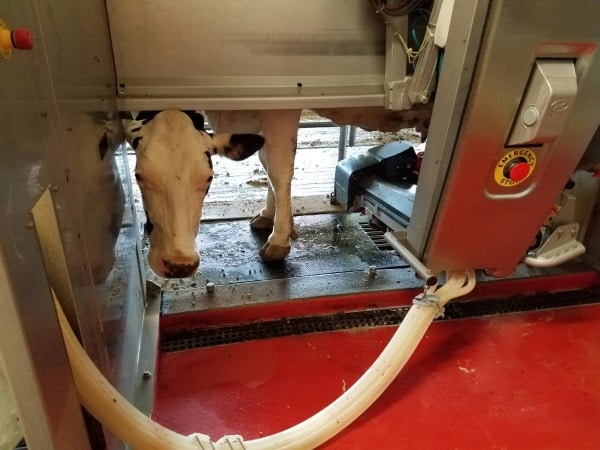Technology improves our lives every day – it’s in our homes, our jobs, our cars… even on dairy farms! It also gives us a means to connect with farmers and find out how our food is made.
See how farmers are stepping up their game and using technology to help them manage the farm and care for animals, all the while making milk.

Connectivity with Cows
“335” is more than a cow’s number at Stoney Path Farm in Pennsylvania. Her special electronic ID collar with a tracking chip gives dairy farmers Jeff and Jesslyn Balmer vital information about the cow. It tracks everything… from the number of times she chews in a day to how much milk she makes.
Other farmers use pedometers (think Fitbit) worn by cows that give electronic updates about their herd and sends an electronic ‘heads up’ to the farmer when there’s a potential problem. Being in the know helps farmers more easily monitor the health and wellness of their animals.

Step Right Up!
Imagine cows getting milked whenever THEY want to… really! More farms, including Stoney Path, and Har-Go Farms in Pavilion, New York, are using robotic milking systems. Cows are given free access to these systems 24 hours a day and choose when to be milked with laser accuracy. Monitoring systems are used to make sure cows don’t come too often. Most choose to be milked 2-3 times a day – the same number milkings that happen on a conventional farm!
There’s an App for That
Fifth generation farmer, Jason Tillotson, at Cottonwood Farms in New York State, uses an app that links him to the farm’s robotic laser milker, making it easier to keep track of how often a cow is milked.
Jason talks about the app in this 2016 Dairying for Tomorrow Award video about Cottonwood Farms.
The Cow Jumped Over the Moon
Ok, not quite… but drones help farmers keep an eye out on their cows and crops alike.
Food for Thought
More farms are adopting the latest technology available to make sure cows are comfortable.
1. Feed pushing robot – automatically pushes feed up to the cows making sure they have a constant supply of food available to them.
2. Misting fans – set on variable speeds, misting fans adjust to changes in temperature… so when it’s hotter in the summer, the fans blow faster.
3. Thermostat-controlled curtains – automatic curtains keep cows comfortable throughout winter. Cows thrive in cold air, so most farmers keep their barns between 50-55 degrees Fahrenheit. But when temperatures dip well below freezing, it’s curtains to the rescue!
Farming is a way of life. It’s a lifestyle that’s catching the eye of more Millennials. The number of principal farmers between the ages of 25 and 34 increased by more than 2% from five years before, shows the USDA census of farmers. The best way to learn about dairy farming is to talk to a dairy farmer…. or watch our YouTube videos about dairy farming.





